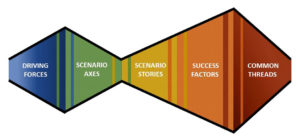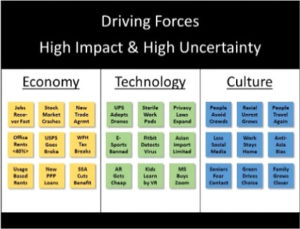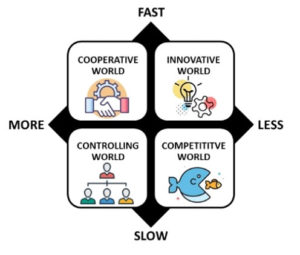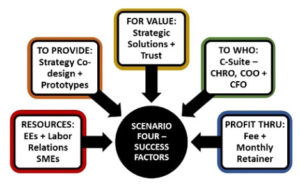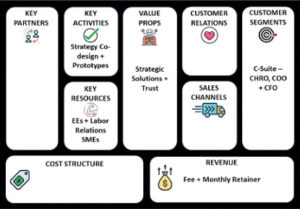If you find it challenging to shape business strategy in this uncertain time, you’re not alone. Three months after the 2020 COVID pandemic emerged in the U.S., McKinsey reported that 90% of executives believed the crisis would fundamentally change their business over five years. Only 21% felt they had the expertise, resources and commitment for successful growth.
Scenario planning is one way to forge a successful strategy in turbulent times. It’s a process that envisions alternate futures, identifies a robust strategy for each of those future scenarios, and discovers the common threads amongst all of them to create a path forward. The objective of scenario planning is not to predict the future, but instead to assure success in multiple futures.
In 1973 Royal Dutch Shell’s scenario planners famously anticipated the oil crisis. They had a strategy ready to thrive while other oil companies suffered. Twenty years later I was fortunate to learn a simplified form of scenario planning from Peter Schwartz, one of Shell’s planning executives. In the years since his GBN workshops, I’ve compressed that process into a five-step Scenario Sprint. Whether you choose to spread this work over a week or a month, in five 90-minute steps you can surface a set of success factors to illuminate your strategic path forward. Here’s how.
Pre-Sprint
First you’ll define your Scenario Sprint challenge and time frame. This should be a broad question such as “How might we position our organization now for success in the next three years?” You will also recruit your Scenario Sprint team members. The ideal team includes 12 – 16 members with diverse experience and insights. They are comfortable with ambiguity and committed to the Sprint’s success. A dedicated facilitator will help the team stay on track – especially if you plan to work together in a purely virtual environment.
Step One: Driving Forces
Step one begins with a 30-minute meeting to introduce the Scenario Sprint challenge, process, and team expectations. This includes detailed instructions on the first assignment: Driving Forces.
This first step identifies environmental forces beyond your organization’s control that could have a profound impact on its future – either positive or negative. You’ll choose eight categories that are important to your organization. They might include government, culture, economics, competition, technology and science.
Each team member will spend about 60 minutes posting 2-3 potential high-impact events in every category. These events should be both plausible and unexpected. This work is best accomplished individually, in a shared physical or virtual workspace.
Step Two: Scenario Axes
Next you’ll set the stage for your scenarios by prioritizing your high-impact events. First you’ll group the events from each category into common themes. Examples of themes include “disruptive technology”, “low unemployment”, or “cybersecurity breach.” If you break your team into small groups, and assign one or two categories per group, you should be able to accomplish this task in 30 minutes.
Next you’ll select 8-10 themes with the highest number of events, and move them to a clean workspace where you can prioritize them by greatest impact. At this point the Scenario Sprint team has a decision to make: which two driving forces are the most important to focus on?
It’s helpful to remember your time frame when choosing your two forces. It’s also good to choose forces that have one extreme or another, such as “fast vs. slow economic recovery” or “more vs. less artificial intelligence.” The two forces you choose become the axes that will guide your scenario stories.
Step Three: Scenario Stories
Your third step creates stories about each scenario, told from your organization’s point of view. Each story will begin with a triggering event from one quadrant on your matrix. If your axis points were slow economic recovery and more artificial intelligence, one story might start with a statement like “The deep recession continues, and only 60% of furloughed workers have been rehired.”
You’ll add cascading events to each story, drawing from your high impact events. You might want to include some events that didn’t make it to your highest impact themes. Try to tell each story with a logical sequence and unexpected outcome. Each story will close with the impact on your organization – positive, negative, or perhaps mixed.
Once again, you can break your team into four groups and assign each one a scenario quadrant. They should be able to create a story and sketch out a storyboard in 60 minutes. That leaves you 30 minutes for each group to share their story with the rest of the team.
Step Four: Success Factors
In step four you’ll continue your stories, creating a “happy ending” for your organization in all four scenarios. You’ll begin with the same five questions for each scenario:
- What products and services will we provide?
- Who will buy these products and services?
- What is our value proposition?
- How will we make a profit?
- What resources will we need?
Divide your team into four small groups and ask them to answer these questions for a single scenario. They should be finished in about 30 minutes. A shared virtual workspace divided into the five questions will help your team to quickly collect, generate and prioritize their ideas.
Each group will spend the next 30 minutes creating a simple diagram to illustrate how the organization succeeds in their given scenario. In the final 30 minutes each group will share their success stories, and ask for their team members’ insights.
Step Five – Common Threads
Your fifth step identifies common threads amongst all of your scenario success strategies, and identifies a path forward. You’ll likely find several common threads that appear in most, or all, success stories. These could indicate a shift from products to services, a marketing focus on a different audience, or a critical new resource for you to develop.
Use your first 30 minutes to identify these common threads and place them in a business model context. Strategyzer’s Business Model Canvas is an easy tool for visualizing the essential elements of a success strategy.
After you’ve populated the canvas with your five common threads, only four fields will remain: relationships, partners, channels and costs. You can either discuss these for the next 30 minutes, or assign them as a Post-Sprint activity.
Your final 30 minutes will be dedicated to dialogue and feedback. What did the team like about the process and outcome? What would you change or eliminate if you had the chance? What would make the process and outcome even better next time? And, most important, how will each member contribute to next steps?
Post-Sprint
After the Scenario Sprint, you and your team may have a whole new view of your organization’s potential. It’s likely your scenarios will surprise, and potentially disturb, those who didn’t help to develop them. Your first Post-Sprint task is to document your work. The second is to create an action plan to engage your broader organization. This might include working together to create a business model based on each scenario’s success factors. Engaging a broad diversity of people in this Post-Sprint work is critical to your third task: environmental scanning.
The Scenario Sprint bears some resemblance to Google’s famous Design Sprint, with one important difference. When you’re designing a product or service for a given set of users, you’re able to seek their feedback and validate your designs. Designing for an uncertain future doesn’t give you that luxury. Instead, you must constantly scan the environment for signs that some of your driving forces are emerging. This is not casual. It’s a scenario planning discipline that’s purposeful, and continues over the life of your planning period. The good news: once you see a driving force emerge, you already have a strategic direction and business model ready to seize the opportunity.
In his TED talk after the 2014 Ebola outbreak, Bill Gates advised organizations to anticipate a global pandemic in their planning scenarios. Who could have predicted COVID-19? Few did. But those who took Gates’ advice in 2015 undoubtedly had a solid plan to survive, and perhaps even thrive, in 2020. Our current environment reminds us how short-sighted it can be to assume “business as usual.” There’s no better time than now to start using scenarios. There’s no better time to design how you’ll succeed in our uncertain future.
©2020 Lisa Perrine


